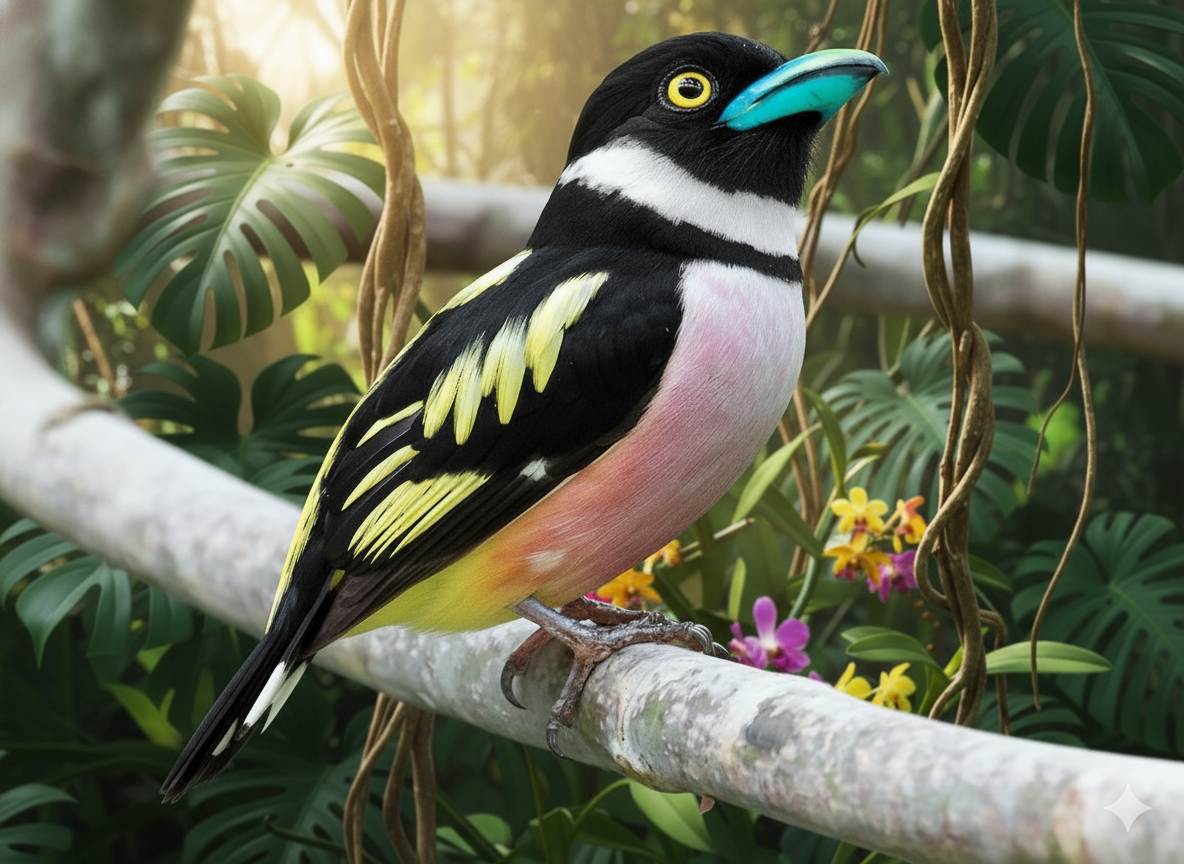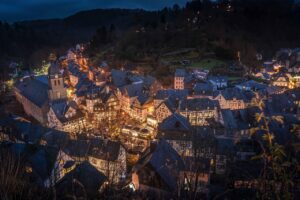Imagine a bird designed by a pop artist—one that combines a black-and-white tuxedo, a punk-rock splash of color, and a bill so bright it looks like it’s battery-powered. In the dense, humid rainforests of Southeast Asia, this isn’t a fantasy. It’s the Black-and-yellow Broadbill (Eurylaimus ochromalus).
This tiny bird, scarcely bigger than a sparrow, is a “vibrant” creature in every sense of the word. It’s a stunning example of tropical beauty, and a true gem for any nature lover to discover.
Here’s what makes this tiny forest-dweller so captivating.
1. A Shocking, Multi-Colored Plumage
The Black-and-yellow Broadbill looks like it was assembled from a dozen different birds. Its plumage is a bold, dazzling patchwork:
-
Head and Back: A deep, glossy black head and back.
-
Collar and Streaks: A clean white collar separates the head from the back, which itself is slashed with a brilliant, golden-yellow V-shape.
-
Chest and Belly: The real surprise is its chest, which is a delicate, vinous-pink that fades into a bright yellow belly.
-
The Bill: The feature that truly sets it apart is its bill. It’s impossibly wide and flat, but the color is what’s truly shocking: a brilliant, sky-blue to aquamarine, tipped with green and edged in black.
This combination of pink, yellow, black, white, and electric blue makes it one of the most vibrant and unmistakable birds in its habitat. The female is just as stunning, though she has a broken (or no) black band across her chest.
2. A Song That Sounds Like a Power Line
For a bird so beautifully dressed, you might expect a melodic song. The Black-and-yellow Broadbill, however, sounds like a piece of the jungle’s machinery.
Its call is not a whistle, but a loud, penetrating, “cicada-like” trill. The song starts as a series of sharp, down-slurred notes that rapidly accelerate, building in pitch and speed until it becomes a high, quivering, electrical-sounding buzz that can last for 8-12 seconds. It’s a sound that perfectly embodies the humid, insect-filled air of the rainforest.
3. An Architect of Bag-Like Nests
This bird’s nest is just as unique as its appearance. The Black-and-yellow Broadbill is a master architect, and both the male and female work together to build a large, complex, and rather untidy nest.
The nest is a large, pear-shaped pouch made of moss, leaves, and fungal strands, suspended from a branch. It often looks like a random clump of forest debris, which provides perfect camouflage. Even more cleverly, they often build their nests over streams or near active wasp nests, using the water or the wasps as a natural deterrent against tree-climbing predators like snakes.
4. An Aerial Insect-Hunter
That massive, wide, flat bill isn’t just for show. It’s a high-precision tool. The Black-and-yellow Broadbill is primarily an insectivore, and its bill is the perfect “fly swatter.”
It’s a “sally-gleaner,” meaning it will sit patiently on a perch in the forest’s mid-level, scanning for movement. When it spots a bug, it darts out in a quick, acrobatic flight to snatch the insect from a leaf or even mid-air. It then returns to its perch to eat, often mashing the insect with its powerful, fleshy tongue and wide beak.
Quick Facts: The Black-and-yellow Broadbill
Scientific Name: Eurylaimus ochromalus
Habitat: Lowland and evergreen rainforests of Southeast Asia (found in Indonesia, Malaysia, Myanmar, Singapore, and Thailand).
Diet: Primarily insects (like mantises, beetles, and orthopterans), but also mollusks.
Conservation Status: Near Threatened. Like many rainforest specialists, its population is declining due to rapid habitat loss from logging and land conversion.
A Jewel of a Fading Forest
The Black-and-yellow Broadbill is a perfect symbol of the rainforest’s rich, hidden biodiversity. It’s a tiny, vibrant, and noisy testament to the wild, artistic beauty of nature. Seeing one, with its electric-blue bill glowing in the dim forest light, is a true “bucket list” moment.
However, as a Near Threatened species, its future is in question. This vibrant gem is a beautiful, urgent reminder of what we stand to lose if these vital forest habitats are not protected.
Have you ever been lucky enough to see a Black-and-yellow Broadbill? Or is this vibrant bird now on your “must-see” list? Let us know in the comments!


